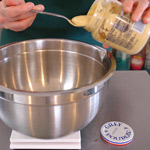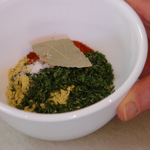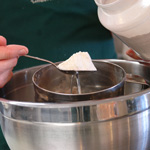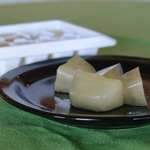| |
How to Use
a Digital Kitchen Scale
Restaurants
measure ingredients by weight. All
of our recipes require a kitchen scale.
If you live in the United States, you probably use measuring cups. Keep
an open mind and don't be frustrated by our recipes. Get a digital
scale and try our technique.
Once
you get used to our system, you will love it.
We measure our food by ounces. If you live outside the U.S. and use the
metric system, multiply ounces by 28.35 to convert to grams.
Why
do we use a kitchen scale instead of a measuring cup?

-
It
is faster. Suppose
we want to measure 1/3 cup of dijon mustard. First we spoon
the
mustard into the measuring cup and level it off. Then
we scrape
it out of the measuring cup and into our mixing bowl.
We have to wash and dry the measuring cup before we can use it
again. But what if our recipe calls for 3 oz of dijon mustard?
We set our mixing bowl on the kitchen scale and press tare. We spoon in
mustard until the scale reads 3 oz. If we accidentally spoon in 3 1/2
oz, we just take a little out and put it back in the mustard jar.

-
It
is easier to shop for produce.
If a soup recipe calls for 11 cups of chopped zucchini, you
have
to estimate how much zucchini to buy. If the recipe calls for 48 oz of
zucchini, you weigh it when you buy it.
-
Recipes
turn out right every time.
Imagine a typical recipe that calls for one green pepper. Green peppers
come in very different sizes. A large green pepper can easily
overwhelm the
flavor of a dish.
If the recipe calls for 4 oz green pepper, you
add exactly the right amount. Maybe it will be a whole small pepper or
just half of a large one.
We write our recipes in a special
way.
We list ingredients in the best order to weigh them. For best results, follow down
the ingredient list in order and do not skip around.
Here are some tips to help you transition to cooking by weight:
-
Use
measuring spoons for herbs and spices. Measure them into
a very  small dry bowl and set aside until needed. small dry bowl and set aside until needed.
-
When you spoon dry ingredients
into a bowl, don't dump them on top of each other. Put them in separate piles.
If you accidentally add too much of one dry ingredient, you can remove
a little with a spoon.
-
 To weigh and sift ingredients, set the sifter
in the bowl and put
the sifter and bowl on the kitchen scale together. Press
tare. Carefully spoon flour into the sifter until you reach the right
weight. To weigh and sift ingredients, set the sifter
in the bowl and put
the sifter and bowl on the kitchen scale together. Press
tare. Carefully spoon flour into the sifter until you reach the right
weight.
If you have another dry ingredient, like cocoa, press tare and
then spoon it into the sifter beside the flour.
If your sifter is too
small to hold all of the dry ingredients, don't sift the flour. Just
sift lumpy ingredients like carob powder, baking powder, and baking
soda.
-
Put
thick wet ingredients like minced garlic, tahini, or
applesauce in
separate piles in your bowl, as with dry ingredients.
-
Liquids
are the tricky part.
First weigh heavy liquids like maple syrup or agave nectar. Then add
medium density liquids like soy sauce, vinegar, or fruit juices. Weigh
water in a pitcher and add it last. Go slowly and pay attention so you
don't overshoot with wet ingredients. It is often hard or impossible to
remove them once they are in the bowl.
-
Wash
and trim produce before you weigh it. Chop or slice
after you weigh it, so you don't chop too much.
Tips for faster meal preparation

How to choose a scale
Here are some tips for choosing
a kitchen scale:
-
Buy
a digital scale. Do not buy a mechanical scale that
works by compressing a spring. They are not reliable.
-
Get
a scale that reads in ounces. When it goes over 1 pound,
it should read "17 oz" and not "1 lb 1 oz". Many scales will read in
several different modes.
-
Be
sure your scale has a tare function.
You can put a bowl on the scale and press the tare button. The scale
reads zero. You add an ingredient by weight. You press tare again and
the scale goes back to zero. You add another ingredient into the bowl
with the first one. You can see how useful the tare function is.
-
Get
a scale that uses batteries. We move our scale
frequently as we cook. The batteries last for a long time.
-
It is best to have a scale with a good sized platform.
It helps if you can put an 8 quart pot on the scale and still read the
scale. However, this is helpful but not essential.

We went through many scales before we found the My Weigh KD-7000. It is an
excellent kitchen scale for home use and you can use it
for postage too. It is available on Amazon. The newest model is the
KD-8000, which would also be a good choice.
If you don't have a scale....
If
you want to try making our recipes without a scale, we hope you really
love
math. :-)
Here are some tips:
-
The
quantities on your measuring cup only work for water,
and maybe for small quantities of light liquids like lemon juice. For
example, one "8 oz" measuring cup of whole wheat flour weighs 4.2 oz. A
cup of cooked black beans weighs 6.1 oz. And a cup of maple syrup
weighs 11.4 oz. Every food has a different density. So every food has a different
weight per cup.
-
You
must use
a nutrition website or nutrition software to convert our weight by
ounces to volume by cups. The most current website is
the USDA National Nutrition Database.
Suppose
a recipe calls for 9 oz of cooked black beans. First convert the ounces
to grams. One ounce
equals 28.35 grams. So 9 oz X 28.35 = 255 grams. You search the
database for cooked black beans and you find that 1 cup of beans weighs
172 grams. Divide 255 by 172 and you get 1.48. Nine ounces of beans is
about 1 1/2 cups.
If you are making a soup or stew, you can
usually make a rough guess
about the weight of produce, grains, or beans. The recipe will still
turn out fine. But for
baked goods, you must convert ingredients accurately or your recipe
will flop.

|






 small dry bowl and set aside until needed.
small dry bowl and set aside until needed. To weigh and sift ingredients, set the sifter
in the bowl and put
the sifter and bowl on the kitchen scale together. Press
tare. Carefully spoon flour into the sifter until you reach the right
weight.
To weigh and sift ingredients, set the sifter
in the bowl and put
the sifter and bowl on the kitchen scale together. Press
tare. Carefully spoon flour into the sifter until you reach the right
weight. 
New! Comments
Have your say about what you just read! Leave us a comment in the box below.